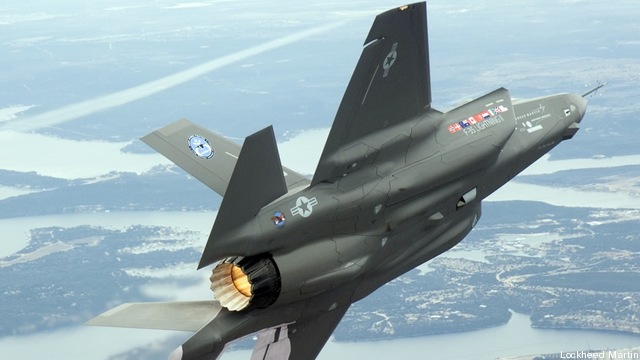Air Force F-35 IOC May Be In Peril; Pratt, DoD Shake On $1B F135 Deal
Posted on
F-35 JOINT PROGRAM OFFICE: When Sen. Kelly Ayotte and her supporters blocked retirement of the A-10 fleet, it’s not likely they knew the F-35 program might suffer.
But that’s exactly what Lt. Gen. Chris Bogdan, head of the huge F-35 program, told reporters this afternoon will happen unless something changes.
In the conference room where the F-35 program makes its biggest decisions two signs mark the wall. They count down the days to Initial Operational Capability of the F-35 for the Marines and for the Air Force: 244 days for the Marines’ F-35B and 641 for the Air Force’s F-35A.
While the Marine date is still doable — though Bogdan concedes it will be tight — the Air Force date is the most threatened.
“Up until today, things were looking pretty good,” Bogdan told us.
For those who don’t follow this stuff on a regular basis, IOC means a military service believes the weapons it has bought are ready for use if needed.
Why is the A-10 fleet’s continuance going to hurt the F-35? It’s a pretty abstruse connection but it’s direct. Among the requirements the Air Force has laid down is that its fleet of F-35As must have a ready pool of 1,100 qualified mechanics to keep them flying. Without that pool the fleet of Air Force Joint Strike Fighters could not be kept in a high enough state of readiness to qualify for IOC.
The A-10 is an aging aircraft that requires its own healthy maintenance corps. Bogdan said he’s been told by the Air Force that it cannot produce enough qualified maintainers because the A-10 fleet needs so many that they can’t free enough experienced people to get trained. Why does their level of experience matter? Because it takes much longer — nine to 12 months longer — to train new maintainers to work on the advanced systems of the F-35 than it does to train those who are experienced.
The Air Force built its requirements for IOC assuming the retirement of the A-10 fleet. While there are more than 600 days remaining til Air Force IOC, this is the sort of obstacle that takes time to find solutions for.
Bogdan offered a broad review of the F-35 program, in addition to his comments about the Air Force IOC. He pledged that the Marine IOC date would not slip more than a few weeks, if any, from the July target date. “If I miss that date, I am going to apologize to the US Marine Corps,” Bogdan told us. (Technically, the JPO has until December next year to meet the benchmark.) “There’s no way in the world we’re missing that by months. It’s not going to happen.”
He also told us the value of the latest contract for 43 F-35s with Lockheed Martin: $4.6 billion. He amended the estimate of the drop in cost for the eighth Low Rate Initial Production (LRIP) deal from 3.6 percent to 3.4 percent as a result of a stronger US dollar.
The F135 engine fix for the plane continues apace. Bogdan said the root cause of the fire that largely destroyed a F-35A on its June 23 takeoff has been found and fixes identified.
Pratt & Whitney’s engine flew apart after titanium blades heated to 1,900 degrees and began to crack. The fissures grew over time until the fan blade cracked. The circular part of the engine stretched out and shot through the left fuel tank, igniting the fire. The company has presented Bogdan with five possible fixes. He said the Pentagon had not made any decision yet about which was most likely, but he talks most regularly about hardening the material against which the titanium blades rub and building some sort of trench where the blades rub to ease the strain.
This evening the Pentagon announced the latest deal with Pratt for the next batch of 48 F135s for a total of $1 billion.
Finally, Bogdan said a report on noise test results will be released tomorrow. In every mode except using the afterburner, the head of the F-35 program said the plane is usually as loud — or a bit quieter — than existing American jet fighters.
Subscribe to our newsletter
Promotions, new products and sales. Directly to your inbox.

